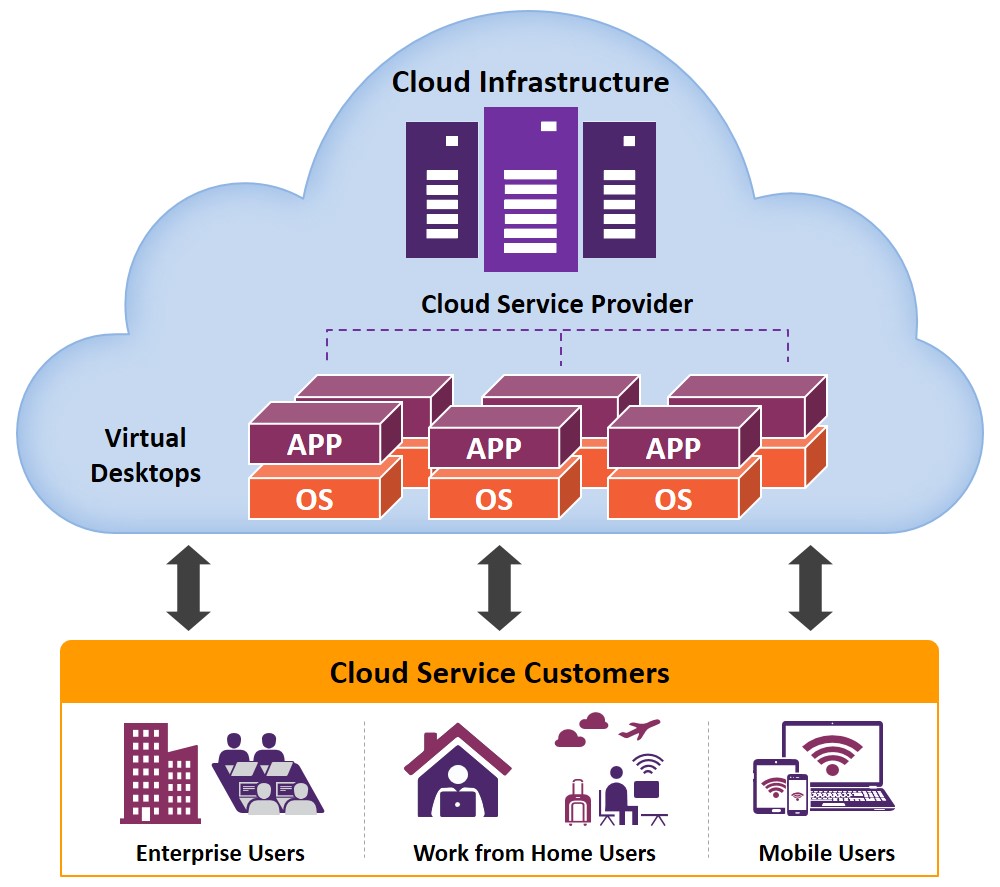Make way for Cloud hosted Desktops

The workplace has evolved. Employees now prefer anytime, anywhere, any device access to enterprise data and application. With changing end-user demand and dynamic business environment, it is time enterprises have a relook at their end-user computing (EUC) strategy to drive workforce productivity and enhance end-user experience.
The increase in number of diverse computing devices with multiple operating systems, continuous application upgrades, transitioning from windows 7 to 10, availability of digital collaboration platforms, and ensuring seamless applications availability for end-users have become more challenging and complex for IT teams. Hardware refresh further complicates enterprise computing environment with large Capex outlay.
Desktop virtualization technologies delivered asVDI (virtual desktop infrastructure) or DaaS(Desktop as a Service)  promises seamless mobility and secure availability of data and applications – addressing key challenges in delivering seamless end-user experience. Enterprises with in-house or collocated data centers often choose the VDI way of virtual desktops as it offers full control over hardware, software and data minimizing the threat of data loss and device theft. However, VDI deployments require upfront Capex and specialized skills to deploy and manage virtual desktops making it an extremely challenging proposition for IT teams.
promises seamless mobility and secure availability of data and applications – addressing key challenges in delivering seamless end-user experience. Enterprises with in-house or collocated data centers often choose the VDI way of virtual desktops as it offers full control over hardware, software and data minimizing the threat of data loss and device theft. However, VDI deployments require upfront Capex and specialized skills to deploy and manage virtual desktops making it an extremely challenging proposition for IT teams.
With large scale adoption of Cloud technology, enterprises now have the flexibility to implement Cloud-hosted desktops delivered as DaaS. DaaS converts Capex spend into Opex and negates the cost of owning specialized technical skills, desktop maintenance and infrastructure depreciation.
Gartner’s Market Guide for DaaS, 2016 estimates that by 2019, 50 percent of new VDI users will be deployed on DaaS platforms.
Let us outline 5 reasons why enterprises will benefit by moving virtual desktops to the Cloud.
Lower Total Cost of Ownership (TCO) – Available as ‘pay-per-use’ model, Cloud converts the upfront Capex (investment required in setting up infrastructure and software licences) into Opex. Also, the effort, time and investment in managing, securing, and upgrading physical desktops are minimized, thereby bringing down the TCO. Fewer onsite support staff, fewer support calls and tickets, reduced cost of application delivery and overall better utilization of resources further reduce the TCO.
Anytime, Anywhere, Any Device Computing – Cloud promises the availability of applications and data to end-users anywhere, anytime and across any device. This addresses the increase in demand for on-the-go workplace and simplify operations for remote workers, making applications available even at low bandwidth in remote locations. In addition to flexibility of being able to access data and application at will, today’s workforce also wants to use devices of their choice (BYOD). Cloud-based DaaS helps with implementation of uniform security protocols across end-user devices, thereby ensuring fully secure and compliant access to corporate data and applications.
Security – Centralized desktop management enables IT teams to make available secure and policy-based access to data and applications. This means enterprises can provide selective access to data and application, and curb end-users from downloading multiple application versions or unnecessary third-party applications, thereby ensuring compliance.
Scalability and Flexibility – Cloud offers the much-needed agility and scalability to ramp up and ramp down workloads as and when needed. This simplifies the tasks of setting up backend infrastructure, implementation and management of virtualized environments. Many DaaS on Cloud providers also take complete ownership of managing and ensuring a secure cloud environment, thus allowing enterprises to not burden themselves with maintaining skilled technical resources.
Business Continuity and Disaster Recovery – DaaS mitigates the challenges in ensuring business continuity and disaster recovery for virtualized desktops on Cloud. In case of any disaster, Cloud-hosted desktops not only ensure all data and applications are safe and secure, but also allow for instant infrastructure duplication at any location of choice, thereby maintaining business continuity.
As enterprises adopt Cloud-based desktops, they need to choose a partner that enables seamless end user computing (EUC) transformation. As a recognized specialist in Cloud and desktop virtualization technologies, Anunta manages over 80,000 end-points for more than 120,000 users globally with 99.98% application availability. Anunta works with global enterprises in successfully designing, implementing and managing EUC environment for enterprises delivering un-matched end-user experience. Our focus on unmatched end-user experience management and operational flexibility makes us the partner of choice for implementing and managing DaaS on Cloud for global enterprises.
Learn more about Anunta’s EUC Transformation Services at: https://www.anuntatech.com
